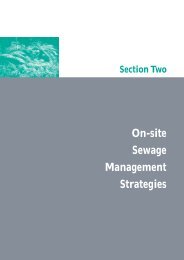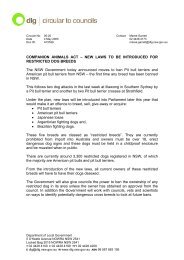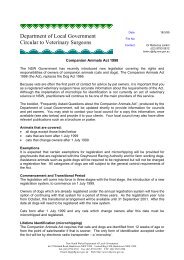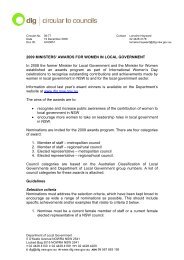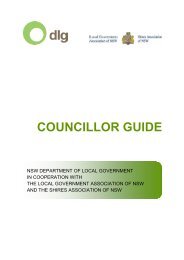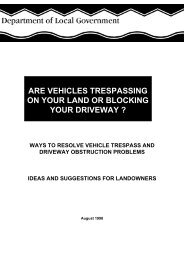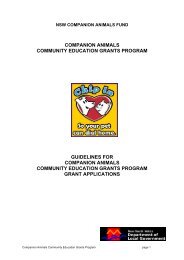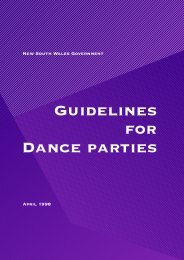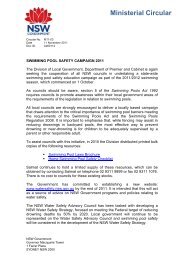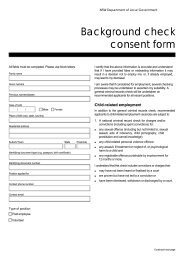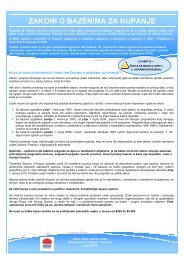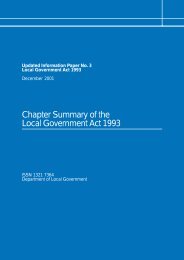Guidelines for Authorised Identifiers - Division of Local Government
Guidelines for Authorised Identifiers - Division of Local Government
Guidelines for Authorised Identifiers - Division of Local Government
Create successful ePaper yourself
Turn your PDF publications into a flip-book with our unique Google optimized e-Paper software.
2. Procedures to be followed when identifying companionanimals2.1 Sterility2.1.1 Only sterile implantation practices are to be used. This includes ensuring andmaintaining the sterility <strong>of</strong> microchips and implantation equipment, andensuring only a sterile microchip is inserted into an animal. Should sterilitynot be maintained, the implantation device is to be discarded. (See Notesbelow <strong>for</strong> details on sterility standards).2.1.2 <strong>Authorised</strong> identifiers other than veterinary surgeons must use single usemicrochip delivery devices that are pre-packed in a sterile package (seeNotes below).2.2 Pre-scanning2.2.1 Clause 8(1)(a) <strong>of</strong> the Regulation provides that be<strong>for</strong>e a microchip is implantedin an animal, the animal is to be scanned to ensure that the animal does notalready have a functioning microchip properly implanted.2.2.2 If the animal is found to have a microchip the implanter must not implant anadditional chip. See section 6.1 <strong>of</strong> this guideline regarding animals alreadymicrochipped.2.2.3 <strong>Authorised</strong> identifiers must be able to scan <strong>for</strong> the presence <strong>of</strong> all <strong>of</strong> themicrochips commonly in use in NSW be<strong>for</strong>e 1 October 1999, as well asapproved microchips (see paragraph 2.4.2 <strong>of</strong> this guideline). As a result,authorised identifiers must have readers capable <strong>of</strong> reading ISO microchipsand <strong>of</strong> detecting (but not necessarily reading) common non-ISO microchips.The current order can be viewed on the Companion Animals website atwww.dlg.nsw.gov.au.2.2.4 Scanning to ensure that a microchip is not already implanted must include;(a) the authorised identifier ensures that the microchip reader isfunctioning properly;(b) the authorised identifier scans with an operating reader held just abovethe hair line <strong>of</strong> the animal;(c) the entire body <strong>of</strong> the animal is scanned, including the limbs, lowerbody and neck;(d) a slow, even pace is employed in scanning;(e) scanning should not stop if a microchip is found. The entire animalmust be scanned to ensure that all microchips are detected (if there ismore than one).2.2.5 Clause 8(1)(b) <strong>of</strong> the Regulation provides that immediately be<strong>for</strong>e a microchipis implanted into an animal, the microchip to be implanted is to be scanned toGuideline 2001/ID3 – Guideline <strong>for</strong> <strong>Authorised</strong> <strong>Identifiers</strong> 3Oct 2001
ensure that it is functioning properly and to check that its scanned number isas shown on any supporting documentation.2.2.6 Checking supporting documentation includes checking that the bar codessupplied are <strong>of</strong> the correct length (15 digits) and the sequence matches that <strong>of</strong>the microchip.2.3 Preparation2.3.1 The authorised identifier must ensure that the area where the microchip is tobe inserted is clean, free <strong>of</strong> excessive dust or dirt, and not infected with anyskin condition or wound.2.3.2 The area <strong>of</strong> skin is to be prepared to ensure that no <strong>for</strong>eign material isintroduced during implantation <strong>of</strong> the microchip. This may be achieved, <strong>for</strong>example, by a thorough wetting <strong>of</strong> the skin with an alcohol preparation.2.3.3 The authorised identifier must ensure that the animal is correctly restrained byan assistant while the area is being prepared.2.4 Implantation2.4.1 The authorised identifier must ensure that the microchip implanted in acompanion animal <strong>for</strong> the purposes <strong>of</strong> section 8 <strong>of</strong> the Act is an approvedmicrochip.2.4.2 The Director General has ordered that approved microchips are those whichcomply with ISO:11784 and ISO:11785, and include a manufacturer codegranted by the International Committee <strong>for</strong> Animal Recording (ICAR).Approved microchips contain 15 digits, no letters, and start with a ‘9’. Chipsthat start with the code ‘999’ are ISO test chips and should not be inserted into companion animals.2.4.3 The authorised identifier must ensure that the animal is correctly restrained byan assistant while the microchip is being inserted.2.4.4 The authorised identifier must ensure haemostasis should an animal bleedfrom the insertion <strong>of</strong> the microchip.2.4.5 Clause 8(1)(c) <strong>of</strong> the Regulation provides that immediately after theimplantation, the animal is to be scanned to confirm proper implantation andfunctioning <strong>of</strong> the microchip.2.5 Explanations2.5.1 The authorised identifier must properly explain the functioning <strong>of</strong> themicrochip to the owner <strong>of</strong> the animal, and explain to the owner theresponsibilities <strong>of</strong> the authorised identifier under the Regulation, the Act andthese guidelines. Where applicable, the difference between the NSWCompanion Animals Register and other animal registers must be explained.Guideline 2001/ID3 – Guideline <strong>for</strong> <strong>Authorised</strong> <strong>Identifiers</strong> 4Oct 2001
2.6 Competency2.6.1 The authorised identifier must maintain a reasonable level <strong>of</strong> competency byproperly inserting a microchip into at least fifteen companion animals <strong>for</strong> thepurposes <strong>of</strong> section 8 <strong>of</strong> the Act per year (see Notes below).NotesIf an authorised identifier is uncertain about sterility, either because <strong>of</strong> excess dirt inthe coat <strong>of</strong> the animal or an infected wound, then implantation should not proceeduntil the situation is remedied. Similarly, if the tip <strong>of</strong> the needle accidentally touchesa non-sterile environment prior to insertion, the needle must be discarded and a newinstrument utilised.Some manufacturers produce a carton or container <strong>of</strong> multiple microchips whichgreatly decreases the cost. Methods where sterility cannot be assured are notacceptable and loose microchips supplied without their own sterile needle must notbe used.Sterility must not be confused with disinfection. For example soaking in disinfectantor disinfecting with alcohol will not ensure sterility. Accepted methods <strong>of</strong> sterilisationsuch as by gamma radiation must be used.The number <strong>of</strong> microchips that an authorised identifier has inserted into companionanimals can be monitored by the Director General via the Register. Withdrawal <strong>of</strong>authorisation can be recommended by the person who accredited an authorisedidentifier if that authorised identifier fails to maintain their competence - see clause11 <strong>of</strong> the Regulation.Guideline 2001/ID3 – Guideline <strong>for</strong> <strong>Authorised</strong> <strong>Identifiers</strong> 5Oct 2001
3. Considerations when identifying companion animals3.1 Identifying and Registering3.1.1 It is important to note that identification and registration are two separatesteps. Generally, authorised identifiers will NOT be able to completeregistration; ie. they will not be able to register animals under the CompanionAnimals Act 1998.3.1.2 The function <strong>of</strong> authorised identifiers under the Act, Regulation and thisguideline is solely to permanently identify animals and to enter theidentification in<strong>for</strong>mation associated with those animals onto the Register.Other functions such as searching the Register or changing details are to becarried out by councils.3.1.3 All authorised identifiers have access to the NSW Companion AnimalsRegister <strong>for</strong> the purpose <strong>of</strong> entering ‘identification in<strong>for</strong>mation’ only. For thispurpose authorised identifiers will have been supplied with a username andpassword to access the Register.3.1.4 At the time <strong>of</strong> issue <strong>of</strong> these guidelines the only authorised identifiers able toprocess registrations are those operating under delegation from a council.The relevant council will have supplied persons operating under delegationwith a four digit council code, a council username and a council password inorder to complete registrations.3.1.5 Authorisation to list animals with the Australian Animal Registry, CentralAnimal Records or any other private database is not related in any way to anauthority to register animals under the Companion Animals Act or on the NSWCompanion Animals Register.3.1.6 The ‘identification in<strong>for</strong>mation’ required <strong>for</strong> each companion animal is providedin clause 9 <strong>of</strong> the Regulation. All ‘identification in<strong>for</strong>mation’ must be provided.3.1.7 Failure to provide complete, accurate and legible ‘identification in<strong>for</strong>mation’ isa breach <strong>of</strong> the Regulation and <strong>of</strong> these guidelines and may result in thewithdrawal <strong>of</strong> accreditation under clause 11 <strong>of</strong> the Regulation.3.1.8 This guideline provides a step-by-step explanation <strong>of</strong> the procedure whichauthorised identifiers must complete <strong>for</strong> each animal identified.3.1.9 This guideline also sets out the responsibilities <strong>of</strong> authorised identifiers instoring and handling ‘identification in<strong>for</strong>mation’.Guideline 2001/ID3 – Guideline <strong>for</strong> <strong>Authorised</strong> <strong>Identifiers</strong> 6Oct 2001
3.2 Privacy and confidentiality3.2.1 Under section 89 <strong>of</strong> the Act it is an <strong>of</strong>fence to make an entry on the NSWCompanion Animals Register other than in the lawful exercise <strong>of</strong> functionsunder the Act. Examples <strong>of</strong> entries that may be in breach <strong>of</strong> this provisioninclude false entries, entries containing any false details or entries made byother persons.3.2.2 Under section 89 <strong>of</strong> the Act it is also an <strong>of</strong>fence to intentionally allow a personto have access to in<strong>for</strong>mation held by you or on the Register other than in thelawful exercise <strong>of</strong> functions under the Act, <strong>for</strong> example by disclosing anaccess code, password or other in<strong>for</strong>mation that allows access to theRegister. The maximum penalty <strong>for</strong> these <strong>of</strong>fences is $2,750.3.2.3 <strong>Authorised</strong> identifiers will be collecting, recording, storing and disposing <strong>of</strong>personal in<strong>for</strong>mation gathered from individuals as part <strong>of</strong> the identificationprocess. These activities must be undertaken in keeping with the overarchingprinciple <strong>of</strong> consideration <strong>for</strong> the privacy <strong>of</strong> individuals and in keeping with theprovisions <strong>of</strong> this guideline.3.2.4 <strong>Authorised</strong> identifiers must not collect, access, attempt to access, allow otherpeople to access, record or use personal in<strong>for</strong>mation except as is necessary<strong>for</strong> the completion <strong>of</strong> ‘identification in<strong>for</strong>mation’ under the Act, Regulation orguidelines.3.2.5 <strong>Authorised</strong> identifiers must not <strong>of</strong>fer or represent themselves as being able todo anything prohibited by paragraph 3.2.4 <strong>of</strong> this guideline.3.2.6 Personal in<strong>for</strong>mation held by authorised identifiers because <strong>of</strong> their activitiesunder the Act, Regulation or guidelines must be promptly provided to theindividual to whom it relates at their request. <strong>Authorised</strong> identifiers mustrequire pro<strong>of</strong> <strong>of</strong> identity to be presented be<strong>for</strong>e providing this in<strong>for</strong>mation.3.2.7 Copies <strong>of</strong> NSW Companion Animals Permanent Identification Forms must notbe sent to third parties (including other animal registers) except as required orallowed by the Act, Regulation or guidelines.3.2.8 Section 89 <strong>of</strong> the Act and clause 34A <strong>of</strong> the Regulation allow identificationin<strong>for</strong>mation to be disclosed to a third party <strong>for</strong> the purpose <strong>of</strong> listing thatin<strong>for</strong>mation on a database which has the primary function <strong>of</strong> lost animalrecovery, but only if the owner <strong>of</strong> the animal to which the in<strong>for</strong>mation relateshas expressly consented to the in<strong>for</strong>mation being so listed. Consent is to beprovided in writing and with the owner’s signature. An unlawful disclosure isan <strong>of</strong>fence with a maximum penalty <strong>of</strong> $2,750.Guideline 2001/ID3 – Guideline <strong>for</strong> <strong>Authorised</strong> <strong>Identifiers</strong> 7Oct 2001
4. Procedures to be followed when entering identificationin<strong>for</strong>mation onto the NSW Companion Animals Register4.1 Options4.1.1 For each animal identified <strong>for</strong> the purposes <strong>of</strong> section 8 <strong>of</strong> the Act, theauthorised identifier must follow one <strong>of</strong> the following procedures:OPTION A: Enter the ‘identification in<strong>for</strong>mation’ directly onto the NSWCompanion Animals Register (‘the Register’) within seven days<strong>of</strong> identification, orOPTION B: Forward the ‘identification in<strong>for</strong>mation’ in the proper hard-copy<strong>for</strong>mat to any local council within three days <strong>of</strong> identification (alist <strong>of</strong> local councils and their contact details is available on theDepartment’s website at www.dlg.nsw.gov.au).Further in<strong>for</strong>mation on each <strong>of</strong> these options is provided below.4.1.2 The only exception to the requirement under 4.1.1 is if the authorised identifieris also operating under the delegation <strong>of</strong> registration agent <strong>for</strong> the purposes <strong>of</strong>clause 11 <strong>of</strong> the Regulation (see 3.1 above). In this case a proper application<strong>for</strong> registration <strong>of</strong> the animal may be made at the same time as the animal isidentified.4.1.3 Those authorised identifiers to whom 4.1.2 applies should refer to Guideline2001/Gen 2 – Guideline on the Exercise <strong>of</strong> Functions under the CompanionAnimals Act.4.2 OPTION A - Entering identification in<strong>for</strong>mation onto the Register direct4.2.1 All authorised identifiers are able to enter ‘identification in<strong>for</strong>mation’ directly onto the Register.4.2.2 Identification in<strong>for</strong>mation can be entered directly onto the Register via theinternet at www.petregistry.nsw.gov.au. When completed, this procedureresults in a Certificate <strong>of</strong> Identification <strong>for</strong> the animal.4.2.3 The authorised identifier and owner should check the in<strong>for</strong>mation <strong>for</strong> errors asauthorised identifiers are not able to alter records. Any undetected errors orchange <strong>of</strong> details must be corrected through a local council.4.2.4 The completed Certificate <strong>of</strong> Identification must be printed out and given tothe owner <strong>of</strong> the animal within seven days <strong>of</strong> identification.4.2.5 The Register has been set up to allow identification in<strong>for</strong>mation to be entereddirectly, removing the requirement <strong>for</strong> a written copy <strong>of</strong> the in<strong>for</strong>mation to bemade. This practice is strongly preferred, however it may not always beGuideline 2001/ID3 – Guideline <strong>for</strong> <strong>Authorised</strong> <strong>Identifiers</strong> 8Oct 2001
possible. If the identification in<strong>for</strong>mation is entered onto the NSW CompanionAnimals Register at a time that the owner <strong>of</strong> the animal is not present,paragraphs 4.2.4 to 4.2.9 <strong>of</strong> this guideline must be followed at the time <strong>of</strong>identification.4.2.6 The authorised identifier must retain the yellow copy <strong>of</strong> the <strong>for</strong>m until theidentification in<strong>for</strong>mation has been entered onto the Register.4.2.7 Once the identification in<strong>for</strong>mation has been entered on the Register and theCertificate <strong>of</strong> Identification <strong>for</strong>warded to the animal owner, the yellow copy <strong>of</strong>the Form may be securely disposed <strong>of</strong> in keeping with section 5.4 <strong>of</strong> thisguideline.4.2.8 The white copy <strong>of</strong> the Form must be dealt with in keeping with part 5 <strong>of</strong> thisguideline.4.2.9 Once the identification in<strong>for</strong>mation has been entered onto the Register theanimal is NOT now registered under the Companion Animals Act.Registration and identification are separate steps and the identification steponly has been completed. The owner must contact any local council in orderto pay the registration fee and have their registration completed.4.3 OPTION B - Forwarding identification in<strong>for</strong>mation to the council4.3.1 The required ‘identification in<strong>for</strong>mation’ must be completed on a NSWCompanion Animals Register Permanent Identification Form (‘the Form’). Noother <strong>for</strong>m is acceptable.4.3.2 Submission <strong>of</strong> in<strong>for</strong>mation using any <strong>for</strong>mat other than the Form may beregarded as a breach <strong>of</strong> the responsibilities <strong>of</strong> an authorised identifier underthis guideline.4.3.3 The authorised identifier must ensure that the owner understands the privacyin<strong>for</strong>mation detailed on the Form. This step is essential either be<strong>for</strong>ecollecting the personal in<strong>for</strong>mation <strong>of</strong> the owner, or as soon as possible aftercollecting the in<strong>for</strong>mation.4.3.4 The Microchipping details section is to be completed and signed by theauthorised identifier who implanted the microchip in the animal. All questionsin this section are compulsory.4.3.5 The Animal Details and Owner details sections <strong>of</strong> the <strong>for</strong>m is to be completedby the owner <strong>of</strong> the animal and this person must sign at the bottom right <strong>of</strong> theForm. The questions about secondary address and secondary contactperson are not compulsory questions and there<strong>for</strong>e may be left blank if theowner wishes.4.3.6 In completing the Microchipping details section <strong>of</strong> the Form the authorisedidentifier must supply their <strong>Authorised</strong> Identifier number, as issued by theDepartment <strong>of</strong> <strong>Local</strong> <strong>Government</strong>.Guideline 2001/ID3 – Guideline <strong>for</strong> <strong>Authorised</strong> <strong>Identifiers</strong> 9Oct 2001
4.3.7 The authorised identifier must ensure that there is a printed sticker <strong>for</strong> themicrochip number attached to each copy (yellow, pink and white) <strong>of</strong> the Formand verify that the sticker number exactly matches the microchip numberimplanted in the animal.4.3.8 The authorised identifier and owner should check the in<strong>for</strong>mation <strong>for</strong> errors asauthorised identifiers are not able to alter records. Any undetected errors orchange <strong>of</strong> details must be corrected through a local council.4.3.9 The pink copy <strong>of</strong> the completed Form is to be given at the time <strong>of</strong> identificationto the person listed as the owner <strong>of</strong> the animal.4.3.10 The yellow copy <strong>of</strong> the completed Form must be <strong>for</strong>warded to any localcouncil, within three days <strong>of</strong> identification. The Form must be placed in asealed envelope marked “Confidential” and to the attention <strong>of</strong> “animalregistration <strong>of</strong>ficer”. A list <strong>of</strong> all NSW local councils and their contact details isavailable on the companion animals website at www.dlg.nsw.gov.au.4.3.11 In the process <strong>of</strong> <strong>for</strong>warding the ‘identification in<strong>for</strong>mation’ to a council, theauthorised identifier must ensure that the in<strong>for</strong>mation is protected againstloss, unauthorised access, use, modification or disclosure, and against allother misuse.4.3.12 Once the ‘identification in<strong>for</strong>mation’ has been completed and <strong>for</strong>warded to acouncil, the animal is NOT now registered under the Companion Animals Act.Registration and identification are separate steps and the identification steponly has been completed. The owner must contact any local council in orderto pay the registration fee and have their registration completed.4.3.13 The white copy <strong>of</strong> the Form must be dealt with in keeping with part 5 <strong>of</strong> thisguideline.Guideline 2001/ID3 – Guideline <strong>for</strong> <strong>Authorised</strong> <strong>Identifiers</strong> 10Oct 2001
5. Use and control <strong>of</strong> white copy <strong>of</strong> the Form5.1 Retention <strong>of</strong> white copy <strong>of</strong> the Form5.1.1 The authorised identifier must retain the white copy <strong>of</strong> the Form <strong>for</strong> at leasttwo years and not more than five years from the date <strong>of</strong> implantation.5.1.2 The authorised identifier may retain the white copy <strong>of</strong> the Form in their ownpossession or custody or in the possession or custody <strong>of</strong> some other suitableperson such as a commercial storage provider.5.1.3 Whether the records are in the custody <strong>of</strong> the authorised identifier or <strong>of</strong> someother person, the authorised identifier must ensure (or to make arrangementsto ensure) the confidentiality, safe keeping, proper preservation and duereturn or destruction <strong>of</strong> the white copy <strong>of</strong> the Form.5.1.4 The authorised identifier must not:(a) abandon or dispose <strong>of</strong> the white copy <strong>of</strong> the <strong>for</strong>m except in keeping withsection 5.4 <strong>of</strong> this guideline;(b) take or send the white copy <strong>of</strong> the Form out <strong>of</strong> New South Wales;(c) damage or alter the white copy <strong>of</strong> the Form;(d) neglect the proper storage <strong>of</strong> the white copy <strong>of</strong> the Form in a way thatcauses or is likely to cause damage to it; or(e) compromise the confidentiality <strong>of</strong> personal in<strong>for</strong>mation contained in thewhite copy <strong>of</strong> the Form.5.2 Transfer <strong>of</strong> in<strong>for</strong>mation into authorised identifier’s own records5.2.1 The authorised identifier may transfer the in<strong>for</strong>mation contained in the whitecopy <strong>of</strong> the Form into their own records provided that the confidentiality,retention, access and disposal provisions <strong>of</strong> this and other relevant guidelinesare complied with.5.2.2 Transfer <strong>of</strong> in<strong>for</strong>mation contained in the white copy <strong>of</strong> the <strong>for</strong>m into theauthorised identifier’s own records does not remove the requirement to retainthe white copy <strong>of</strong> the <strong>for</strong>m <strong>for</strong> at least 2 years.5.3 Records management and access to in<strong>for</strong>mation5.3.1 The authorised identifier must establish and maintain a records managementprogram <strong>for</strong> the white copies <strong>of</strong> the Form, or the in<strong>for</strong>mation contained in theForm, that ensures that the confidentiality <strong>of</strong> the in<strong>for</strong>mation is maintained.Guideline 2001/ID3 – Guideline <strong>for</strong> <strong>Authorised</strong> <strong>Identifiers</strong> 11Oct 2001
5.3.2 The records management program must be capable <strong>of</strong> retrieving specifiedwhite copies <strong>of</strong> the Form, or the in<strong>for</strong>mation contained in the Form, onrequest. It is recommended that Forms or records be capable <strong>of</strong> beingretrieved based on microchip number or on a description <strong>of</strong> the animals’species and breed. It is not adequate that Forms or records are accessibleonly by owner’s name.5.3.3 <strong>Authorised</strong> identifiers must comply with all reasonable requests from theDepartment <strong>of</strong> <strong>Local</strong> <strong>Government</strong> or authorised <strong>of</strong>ficers <strong>of</strong> a local council <strong>for</strong>access to individual white copies <strong>of</strong> the <strong>for</strong>m and/or the in<strong>for</strong>mation containedin them.5.3.4 Where an authorised identifier has transferred in<strong>for</strong>mation into their ownrecords and the records management system complies with theserequirements, it is no longer necessary to ensure retrieval <strong>of</strong> physical copies<strong>of</strong> the Form <strong>for</strong> the purposes <strong>of</strong> access to in<strong>for</strong>mation. However provisionsrelating to the retention <strong>of</strong> the <strong>for</strong>m, protection <strong>of</strong> confidentiality anddestruction still apply.5.3.5 A record may be in such a <strong>for</strong>m that in<strong>for</strong>mation can only be produced ormade available from it by means <strong>of</strong> the use <strong>of</strong> particular equipment orin<strong>for</strong>mation technology (such as computer s<strong>of</strong>tware). In this case theauthorised implanter is responsible to ensure that the in<strong>for</strong>mation remainsable to be produced or made available <strong>for</strong> at least two years from the date <strong>of</strong>implantation.5.3.6 Paragraph 5.3.5 also applies to record management programs.5.4 Disposal <strong>of</strong> in<strong>for</strong>mation5.4.1 Securely disposing <strong>of</strong> the yellow copy <strong>of</strong> the Form, white copy <strong>of</strong> the Formand/or any other written personal in<strong>for</strong>mation acquired during the completion<strong>of</strong> ‘identification in<strong>for</strong>mation’, means disposing <strong>of</strong> the in<strong>for</strong>mation in a waywhich protects against loss, unauthorised access, use, modification ordisclosure, and against all other misuse. It is suggested that the documentsbe shredded.5.5 Loss or destruction <strong>of</strong> in<strong>for</strong>mation5.5.1 In the case <strong>of</strong> suspected loss or unintended destruction at any time <strong>of</strong> thewhite copy <strong>of</strong> the Form, yellow copy <strong>of</strong> the Form and/or any other writtenpersonal in<strong>for</strong>mation acquired during the completion <strong>of</strong> ‘identificationin<strong>for</strong>mation’, the authorised implanter must take all reasonable steps torecover the in<strong>for</strong>mation or to ensure that the in<strong>for</strong>mation has been properlydisposed <strong>of</strong> in keeping with section 5.4 <strong>of</strong> this guideline.5.5.2 In the case <strong>of</strong> loss or unintended destruction <strong>of</strong> the white copy <strong>of</strong> the Formwithin the 2 year period, the authorised implanter must immediately notify theDepartment <strong>of</strong> <strong>Local</strong> <strong>Government</strong> at the earliest opportunity or within 14 days.Guideline 2001/ID3 – Guideline <strong>for</strong> <strong>Authorised</strong> <strong>Identifiers</strong> 12Oct 2001
5.5.3 In the case <strong>of</strong> loss or unintended destruction within the 2 year period theauthorised implanter must comply with all reasonable requests by theDepartment <strong>of</strong> <strong>Local</strong> <strong>Government</strong> to contact the relevant owners <strong>of</strong> theanimals and to take any other steps necessary to ensure the integrity <strong>of</strong> thein<strong>for</strong>mation on the Register.Guideline 2001/ID3 – Guideline <strong>for</strong> <strong>Authorised</strong> <strong>Identifiers</strong> 13Oct 2001
6. Other requirements6.1 Animals with existing microchips6.1.1 Animal owners may approach authorised identifiers to scan their animals tocheck whether or not their animal already has an existing microchip. If so,they will need pro<strong>of</strong> <strong>of</strong> that microchip in order to register their animal under theAct.6.1.2 In these circumstances, or in any other case where the authorised identifierhas not inserted the microchip in the animal, the authorised identifier mustNOT complete a Permanent Identification Form.6.1.3 Instead, the authorised identifier should use the Verification <strong>of</strong> ExistingMicrochip Form. The owner is to be provided with the (colour) copy <strong>of</strong> theForm. The white copy <strong>of</strong> the Form is to kept by the authorised identifier inkeeping with part 5 <strong>of</strong> this guideline.6.1.4 The authorised identifier is not required to take any further action with regardto the in<strong>for</strong>mation obtained.6.1.5 It is recommended that authorised identifiers refer the owner to the relevantcouncil. The council will check that no record <strong>of</strong> the animal already exists,and where appropriate will enter the ‘identification in<strong>for</strong>mation’ on the Registerthemselves and complete the registration <strong>of</strong> the animal.6.2 Listing animals with other registers6.2.1 Copies <strong>of</strong> NSW Companion Animals Register Permanent Identification Formsmust not to be sent to third parties (including other animal registers) except asrequired or allowed by the Act, Regulation or guidelines.6.2.2 Where an owner wishes to enter their details onto a commercial register theauthorised identifier must ensure that the owner understands the differencebetween the NSW Companion Animals Register and the commercial register<strong>of</strong> the owner’s choice.6.2.3 Where an owner wishes to enter their details onto a commercial register (ie.any register other than the NSW Companion Animals Register) thein<strong>for</strong>mation must be provided in keeping with the provisions <strong>of</strong> paragraph3.2.8 <strong>of</strong> this guideline.Guideline 2001/ID3 – Guideline <strong>for</strong> <strong>Authorised</strong> <strong>Identifiers</strong> 14Oct 2001
6.3 Your contact details6.3.1 It is the responsibility <strong>of</strong> an authorised identifier to notify the Department <strong>of</strong><strong>Local</strong> <strong>Government</strong> about any change in address or contact details as soon aspossible.6.3.2 <strong>Authorised</strong> identifiers who are veterinary surgeons are required by clause 13<strong>of</strong> the Veterinary Surgeons Regulation 1995 to notify the Veterinary SurgeonsBoard <strong>of</strong> a change <strong>of</strong> details within 14 days <strong>of</strong> the change. This guidelinerequires that veterinary surgeons when making this notification also request inwriting that the Board notify the Department.6.3.3 Other authorised identifiers must notify the Department direct, by fax on (02)9793 0899 or by email to pets@dlg.nsw.gov.au, quoting the authorisedidentifier’s name and the number issued by the Department.7. Further in<strong>for</strong>mationProvisions relating to the responsibilities <strong>of</strong> authorised identifiers, includingauthorisation and withdrawal <strong>of</strong> authorisation, are outlined in Parts One and Two <strong>of</strong>the Companion Animals Regulation 1999, as amended. Full copies <strong>of</strong> the Act andthe Regulation can be viewed on the companion animals website atwww.dlg.nsw.gov.au. Copies <strong>of</strong> legislation may also be purchased from the<strong>Government</strong> In<strong>for</strong>mation Service, Ground Floor, Goodsell Bldg, 8-12 Chifley Square,Sydney or 130 George St, Parramatta; phone (02) 9743 7200 to order.The Department <strong>of</strong> <strong>Local</strong> <strong>Government</strong> issues Circulars to <strong>Authorised</strong> <strong>Identifiers</strong> fromtime to time. Topics covered in past circulars include instructions on accessing theNSW Companion Animals Register, issues to do with pro<strong>of</strong> <strong>of</strong> desexing, dealing withanimals with existing microchips, and so on. All authorised identifiers shouldfamiliarise themselves with the contents <strong>of</strong> these circulars, and keep copies handy.All previously issued Circulars may be seen on (and printed from) the Department’scompanion animals website, at www.dlg.nsw.gov.au.The website also has copies <strong>of</strong> various Frequently Asked Questions publications,brochures, posters and other in<strong>for</strong>mation relating to the Act. You may copy any <strong>of</strong>this in<strong>for</strong>mation <strong>for</strong> your clients.A full list <strong>of</strong> NSW councils and their contact details is available on the Department’sgeneral website at www.dlg.nsw.gov.au.AcknowledgmentThe assistance <strong>of</strong> the Companion Animals Ministerial Advisory Board, the NSWVeterinary Surgeons Board and the NSW <strong>Division</strong> <strong>of</strong> the Australian VeterinaryAssociation in the preparation <strong>of</strong> these guidelines is acknowledged.Date <strong>of</strong> issue: October 2001Guideline 2001/ID3 – Guideline <strong>for</strong> <strong>Authorised</strong> <strong>Identifiers</strong> 15Oct 2001



